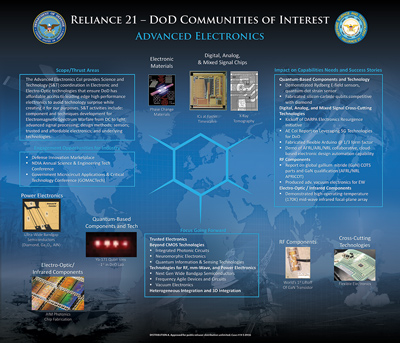Advanced Electronics
Communities of Interest
The advanced electronics technologies encompassed by the Advanced Electronics CoI include those that provide for the processing of information; detection of chemical, biological, radiological and nuclear threats; radio frequency (RF) sensing, transmission, communication; electro-optical/infrared (EO/IR) sensing, transmission, and communication; motion detection including assured references; and the underlying enabling technologies, among others.
Electronics Integration
Packaging and Reliability
- To create and explore new concepts, components and techniques for:
- Planar and 3D integrated circuits
- High power and dense packaging
- Power electronics
- Test
- To overcome these technical challenges:
- Heterogeneous integration with intimate integration of digital control and reconfiguration
- Device design, fabrication, reliability and robustness for high voltages and high currents
- Inability to exploit advances in wide bandgap semiconductor technologies with advanced dielectric and magnetic materials
- Computational electronics or modeling and simulation
- To gain the following operational opportunities:
- Operation in harsh environments with superior thermal management for military systems
- Higher performance for size, weight and power constrained platforms
- Higher power density and efficiency at high voltages
Electronic Materials
Synthesis and Characterization
- To create and explore new materials:
- With tailored responses: metamaterials, multi-ferroics, oxides and phase-change materials
- For infrared focal plane arrays, quantum optics, mmW RF photonics
- For novel low power, high-speed devices for heterogeneous integration with silicon
- For leading edge trusted silicon integrated circuits
- For high-current, high-density cathodes
- To overcome these technical challenges:
- Lack of high quality growth techniques and characterization methods
- Immature bottom-up and top-down assembly techniques for nanoelectronic materials
- Inability to model and simulate materials under operational conditions over time
- Computational Electronics
- To gain the following operational opportunities:
- Advanced sensing, electronic warfare, information technology, communication and imaging
EO/IR Components sensing, transmission and communication
- To create and explore new concepts, components and techniques for:
- Advanced sensors, sources, and optical components for the generation, transmission and detection of ultraviolet, visible and infrared radiation
- RF and mmW photonic devices and circuits
- Electro-optical quantum components for sensors, information and computation
- Advanced focal plane arrays- sensors and read-out integrated circuits
- To overcome these technical challenges:
- Inability to heterogeneously integrate disparate semiconductors - fabrication, reliability and robustness
- Inability to model and simulate devices and circuits under operational conditions over time - Computational electronics
- Inability to exploit advances in electronic materials
- To gain these operational opportunities:
- Improved sensing and signal processing for ISR, tracking and targeting, electronic warfare, information technology and communication systems
- Advanced infrared countermeasures
- Directed energy
Microelectronics and Nanoelectronics
Mixed Signal, Digital Processing and Emerging Architectures
- To create and explore new concepts, components and techniques for:
- Beyond silicon and Moore's Law concepts for digital, high frequency and electro-optic devices
- Quantum components for sensors, information and computation
- Low-power, high-speed devices to heterogeneous integrate with silicon
- Leading-edge, trusted silicon integrated circuits
- Micro-electromechanical and micro-optoelectromechanical systems
- More digital and cognitive apertures
- Extreme miniaturization - higher functionality per unit volume
- To overcome these technical challenges:
- Limited availability of trusted, high-quality, affordable foundries and packaging houses
- Inability to model and simulate materials under operational conditions over time - Computational Electronics
- Inability to exploit advances in electronic materials and device models
- To gain the following operational opportunities:
- Advanced sensing, electronic warfare, information technology and communication systems
- Improved device reliability and robustness
RF Components for sensing, transmission and communication
- To create and explore new concepts, components and techniques for:
- Lightweight, miniature, efficient and affordable wide-bandwidth, high-linearity wide bandgap semiconductor devices / vacuum power electronics that cover frequencies from ~ 1 MHz to ~ 10 THz
- Extremely low power devices for mixed signal integrated circuits
- Advanced control components (filters, switches, etc.)
- Advanced computational electromagnetic techniques and methods
- Technologies that are reconfigurable and adaptive - both active and passive
- To overcome these technical challenges:
- Limited technologies for reconfigurability
- Limited ability to meet extreme military operational requirements
- Shortfalls in efficiency, thermal management and performance
- Limited design tools, models and designs for bandwidth, efficiency and linearity goals
- To gain these operational opportunities:
- Next generation cognitive and adaptive sensors and countermeasures
- Improved device reliability and robustness
- Advanced electromagnetic sensor, communication, electronic warfare, imaging and directed energy (high power microwave) systems
